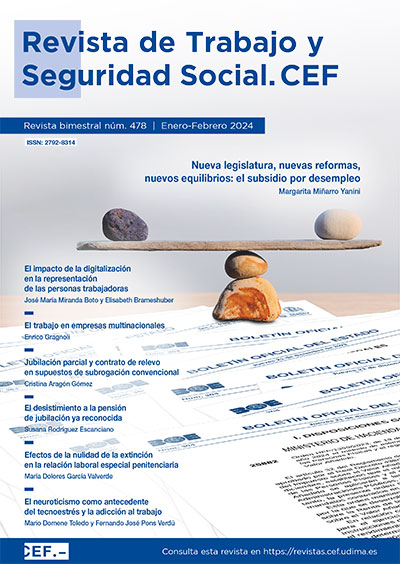Legal nature of active insertion income. The gateway to contributory benefits of Social Security
DOI:
https://doi.org/10.51302/rtss.2024.19433Keywords:
active insertion income, legal nature, unemployment subsidy, assimilated to employment, welfare benefit, contributory benefits, Social SecurityAbstract
The present paper analyzes the legal nature of the active insertion income (RAI) from a normative perspective, and especially from a doctrinal point of view. Different judgments from the Supreme Court (TS) and the High Courts of Justice (TSJ) have established methodological premises that contribute to defining the legal nature of RAI and to overcoming the ambiguity caused by the different royal decrees regulating RAI. Furthermore, this judicial doctrine has allowed: (1) equating the exhaustion of RAI to the exhaustion of unemployment benefits, which is required to access unemployment benefits for individuals over 55 years old, and (2) relativizing the requirement of being in a situation assimilated to being registered as employed in order to access contributory benefits. However, there are specific cases that have not yet come before the TS but have been resolved by the TSJ, albeit with varying pronouncements and a lack of uniformity of criteria. Therefore, it is desirable to have a common criterion adopted by the legislative and/or judicial authorities, which would provide greater legal certainty for this group, precisely because of their personal circumstances, we should avoid excluding them from society and protect them from poverty or social exclusion.
Downloads
References
Botí Hernández, E. (2014). La renta activa de inserción: problemática interpretativa y reforma de 2012. Anales de Derecho, 32, 1-22. https://revistas.um.es/analesderecho/article/view/184481
Cavas Martínez, F. (2003). Protección por el desempleo e inserción laboral: balance provisional de los programas de renta activa de inserción 2000/2003. Aranzadi Social, 5, 191-202.
Cristóbal Roncero, R. (2002). El programa de la renta activa de inserción en la Ley 42/2002. En A. V. Sempere Navarro (Coord.), Empleo, despido y desempleo tras las reformas del 2002 (pp. 277-292). Aranzadi.
Esteban Legarreta, R. (2006). La renta activa de inserción. Tirant lo Blanch.
Fernández Avilés, J. A. (2002). El programa de renta activa de inserción para el año 2002 (Comentario a la disposición adicional 1.ª del RDL 5/2002, de 24 de mayo). Civitas. Revista Española de Derecho del Trabajo, 114, 883-926.
López Insua, B. (2015). La renta activa de inserción como instrumento de lucha contra la exclusión social. En La protección por desempleo en España. XII Congreso Nacional de la Asociación Española de Salud y Seguridad Social (pp. 385-397). Laborum.
Moreno Domínguez, M. (2004). La protección pública no contributiva frente a la exclusión social. Análisis jurídico-económico. Mergablum.
Moreno Gené, J. (2020). Naturaleza jurídica de la renta activa de inserción: nueva oportunidad de clarificación a propósito del acceso al subsidio especial de prejubilación. IUSLabor. Revista d'Anàlisi de Dret del Treball, 2, 101-130. https://doi.org/10.31009/IUSLabor.2020.i02.05
Moreno Gené, J. y Romero Burillo, A. M.ª (2007). El nuevo régimen jurídico de la renta activa de inserción (A propósito del Real Decreto 1369/2006, de 24 de noviembre). Thomson Aranzadi.
Noguera, J. A. (2001). La renta básica y el principio contributivo. En D. Raventós (Coord.), La renta básica. Por una ciudadanía más libre, más igualitaria y más fraterna (pp. 63-106). Ariel.
Rodríguez Pastor, G. E. (2015). Renta activa de inserción y programa de recualificación profesional de las personas que agoten su protección por desempleo. En R. Roqueta Buj y G. E. Rodríguez Pastor (Coords.), Crisis económica y medidas ante el desempleo (pp. 319-355). Tirant lo Blanch.
Saragossà i Saragossà, J. V. (2014). Comentarios a la renta activa de inserción. En R. Roqueta Buj y C. Tatay Puchades (Coords.), Puntos críticos en la protección por desempleo y el cese de la actividad autónoma (pp. 145-159). Thomson Reuters.
Selma Penalva, A. (2016). Aspectos prácticos, perspectivas de futuro y cuestiones controvertidas de la renta activa de inserción. Revista de Información Laboral, 9, 41-67.


















